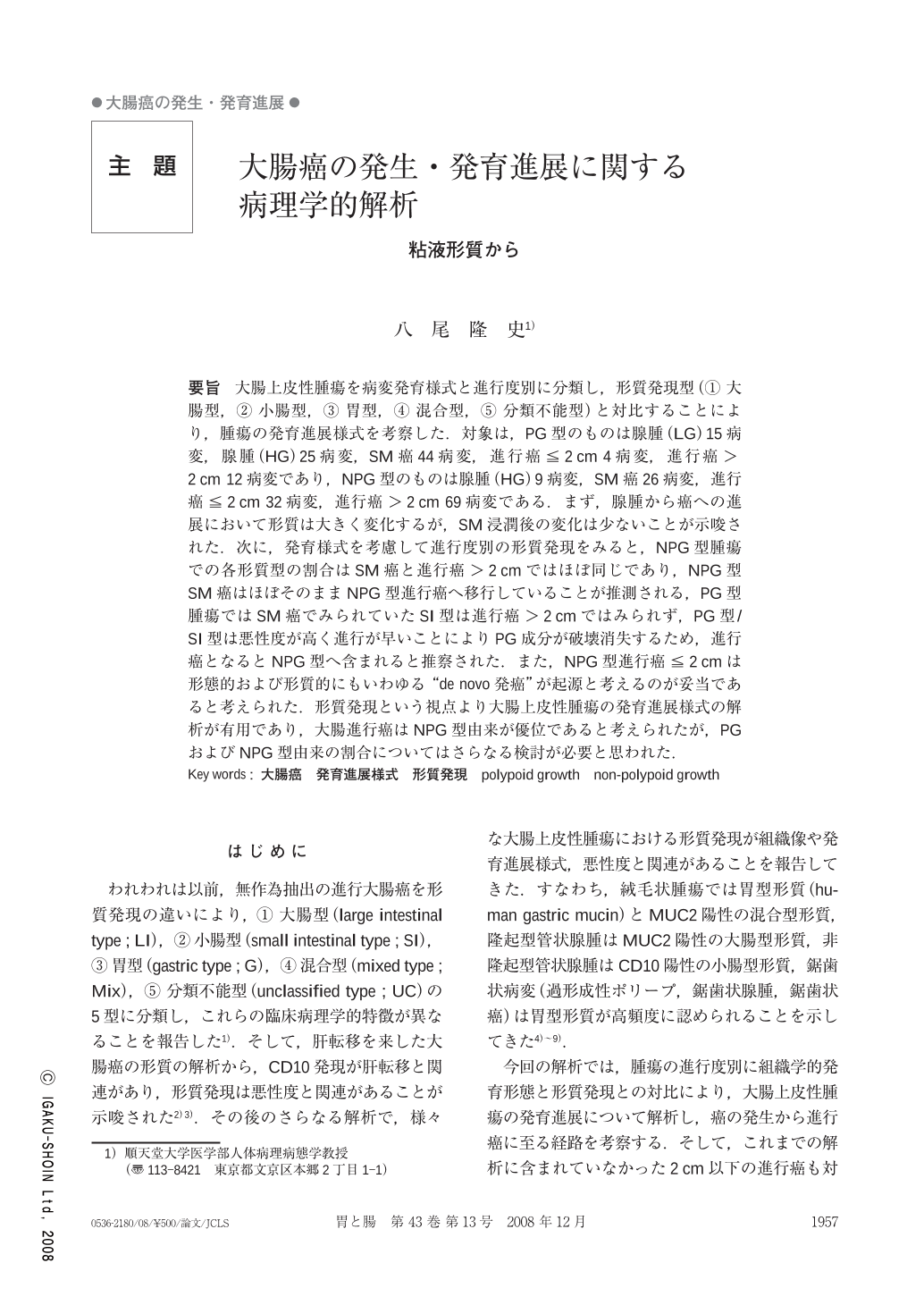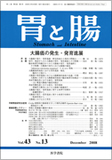Japanese
English
- 有料閲覧
- Abstract 文献概要
- 1ページ目 Look Inside
- 参考文献 Reference
- サイト内被引用 Cited by
要旨 大腸上皮性腫瘍を病変発育様式と進行度別に分類し,形質発現型(① 大腸型,② 小腸型,③ 胃型,④ 混合型,⑤ 分類不能型)と対比することにより,腫瘍の発育進展様式を考察した.対象は,PG型のものは腺腫(LG)15病変,腺腫(HG)25病変,SM癌44病変,進行癌≦2cm 4病変,進行癌>2cm 12病変であり,NPG型のものは腺腫(HG)9病変,SM癌26病変,進行癌≦2cm 32病変,進行癌>2cm 69病変である.まず,腺腫から癌への進展において形質は大きく変化するが,SM浸潤後の変化は少ないことが示唆された.次に,発育様式を考慮して進行度別の形質発現をみると,NPG型腫瘍での各形質型の割合はSM癌と進行癌>2cmではほぼ同じであり,NPG型SM癌はほぼそのままNPG型進行癌へ移行していることが推測される,PG型腫瘍ではSM癌でみられていたSI型は進行癌>2cmではみられず,PG型/SI型は悪性度が高く進行が早いことによりPG成分が破壊消失するため,進行癌となるとNPG型へ含まれると推察された.また,NPG型進行癌≦2cmは形態的および形質的にもいわゆる “de novo発癌"が起源と考えるのが妥当であると考えられた.形質発現という視点より大腸上皮性腫瘍の発育進展様式の解析が有用であり,大腸進行癌はNPG型由来が優位であると考えられたが,PGおよびNPG型由来の割合についてはさらなる検討が必要と思われた.
The carcinogenetic and progressive pathway of colorectal adenocarcinoma was analyzed from the point of view of the phenotypic expression. The phenotypes were divided into five (large intestinal-, small intestinal-, gastric-, mixed-, and unclassified-phenotypes). The growth patterns were divided into two (polypoid growth : PG, non-polypoid growth : NPG). In all,236 lesions were selected for this study, including 100 PG-type tumors (15 low-grade adenomas,25 high-grade adenomas,44 submucosal invasive carcinomas : SM-Ca,4 advanced carcinomas less than 2cm in diameter : Ad-Ca≦2cm, and 12 advanced carcinomas larger than 2cm : Ad-Ca>2cm) and 136 NPG-type tumors (0 low-grade adenomas,9 high-grade adenomas,26 SM-Ca,32 Ad-Ca≦2cm, and 69 Ad-Ca>2cm).
The phenotypic expression tended to change during progression from adenoma to carcinoma, however, it tended not to change after invading the submucosa. The ratio of phenotypic types in SM-Ca was almost the same as that in Ad-Ca>2cm among NPG-type tumors, which suggested that NPG-type SM-Ca just shift to the NPG-type Ad-Ca>2cm. In contrast, the small intestinal-phenotype seen in PG-type SM-Ca was lost in the PG-type Ad-Ca>2cm, which suggested that the PG-type SM-Ca of small intestinal-phenotype might shift to the NPG-type Ad-Ca>2cm during its progression. This might be supported by the high-grade malignancy of small intestinal-phenotype in which the PG component in SM-Ca disappeared due to destruction by invasion during its progression. In addition, it was also suggested that Ad-Ca≦2cm originated from de novo carcinoma.
The phenotypic point of view is considered to be useful for the analysis of the carcinogenetic and progressive pathway of colorectal tumors. From this study, the major colorectal carcinogenetic is considered to be‘de novo', but further analysis is required for clarifying the exact ratio of ‘de novo' to adenoma-carcinoma sequence.

Copyright © 2008, Igaku-Shoin Ltd. All rights reserved.


